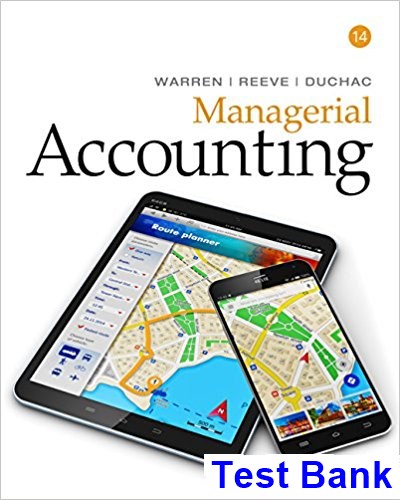Instant download Managerial Accounting 14th Edition Warren Test Bank pdf docx epub after payment.

Product details:
- ISBN-10 : 1337270598
- ISBN-13 : 978-1337270595
- Author: Carl S. Warren; James M. Reeve; Jonathan Duchac
Warren/Reeve/Duchac’s MANAGERIAL ACCOUNTING 14E provides the foundation in managerial accounting fundamentals that you need to succeed by clearly showing how accounting is important to business. Business examples and a unique chapter schema provide context for readers, demonstrating how each chapter’s content fits into the big picture, connecting fundamental concepts with real businesses. Additionally, MANAGERIAL ACCOUNTING 14E and CENGAGENOWv2 provide students with a range of activities that address each stage of the learning process from motivation to mastery.
Table of contents:
- Chapter 1: Introduction to Accounting and Business
- Nature of Business and Accounting
- Generally Accepted Accounting Principles (GAAP)
- The Accounting Equation
- Business Transactions and the Accounting Equation
- Financial Statements
- Chapter Summary
- Key Terms
- Practice
- Answers
- Discussion Questions
- Basic Exercises
- Exercises
- Problems: Series A
- Problems: Series B
- Continuing Problem
- Analysis for Decision Making
- Take It Further
- Chapter 2: Analyzing Transactions
- Using Accounts to Record Transactions
- Double-Entry Accounting System
- Posting Journal Entries to Accounts
- Trial Balance
- Chapter Summary
- Key Terms
- Practice
- Answers
- Discussion Questions
- Basic Exercises
- Exercises
- Problems: Series A
- Problems: Series B
- Continuing Problem
- Analysis for Decision Making
- Take It Further
- Chapter 3: The Adjusting Process
- Nature of the Adjusting Process
- Adjusting Entries for Accruals
- Adjusting Entries for Deferrals
- Adjusting Entries for Depreciation
- Summary of Adjusting Process
- Adjusted Trial Balance
- Chapter Summary
- Key Terms
- Practice
- Answers
- Discussion Questions
- Basic Exercises
- Exercises
- Problems: Series A
- Problems: Series B
- Continuing Problem
- Analysis for Decision Making
- Take It Further
- Chapter 4: Completing the Accounting Cycle
- Flow of Accounting Information
- Financial Statements
- Closing Entries
- Accounting Cycle
- Illustration of the Accounting Cycle
- Fiscal Year
- Appendix 1 End-of-Period Spreadsheet
- Appendix 2 Reversing Entries
- Chapter Summary
- Key Terms
- Practice
- Answers
- Discussion Questions
- Basic Exercises
- Exercises
- Problems: Series A
- Problems: Series B
- Continuing Problem
- Comprehensive Problem 1
- Analysis for Decision Making
- Take It Further
- Chapter 5: Accounting for Merchandising Businesses
- Nature of Merchandising Businesses
- Merchandising Transactions
- Financial Statements for a Merchandising Business
- The Adjusting and Closing Process
- Appendix The Periodic Inventory System
- Chapter Summary
- Key Terms
- Practice
- Answers
- Discussion Questions
- Basic Exercises
- Exercises
- Problems: Series A
- Problems: Series B
- Comprehensive Problem 2
- Analysis for Decision Making
- Take It Further
- Chapter 6: Inventories
- Control of Inventory
- Inventory Cost Flow Assumptions
- Inventory Costing Methods under a Perpetual Inventory System
- Inventory Costing Methods under a Periodic Inventory System
- Comparing Inventory Costing Methods
- Reporting Inventory in the Financial Statements
- Appendix Estimating Inventory Cost
- Chapter Summary
- Key Terms
- Practice
- Answers
- Discussion Questions
- Basic Exercises
- Exercises
- Problems: Series A
- Problems: Series B
- Analysis for Decision Making
- Take It Further
- Chapter 7: Internal Control and Cash
- Sarbanes-Oxley Act
- Internal Control
- Cash Controls over Receipts and Payments
- Bank Accounts
- Bank Reconciliation
- Special-Purpose Cash Funds
- Financial Statement Reporting of Cash
- Chapter Summary
- Key Terms
- Practice
- Answers
- Discussion Questions
- Basic Exercises
- Exercises
- Problems: Series A
- Problems: Series B
- Analysis for Decision Making
- Take It Further
- Chapter 8: Receivables
- Classification of Receivables
- Uncollectible Receivables
- Direct Write-Off Method for Uncollectible Accounts
- Allowance Method for Uncollectible Accounts
- Comparing Direct Write-Off and Allowance Methods
- Notes Receivable
- Reporting Receivables on the Balance Sheet
- Chapter Summary
- Key Terms
- Practice
- Answers
- Discussion Questions
- Basic Exercises
- Exercises
- Problems: Series A
- Problems: Series B
- Analysis for Decision Making
- Take It Further
- Chapter 9: Long-Term Assets: Fixed and Intangible
- Nature of Fixed Assets
- Accounting for Depreciation
- Disposal of Fixed Assets
- Natural Resources
- Intangible Assets
- Financial Reporting for Long-Term Assets: Fixed and Intangible
- Appendix Exchanging Similar Fixed Assets
- Chapter Summary
- Key Terms
- Practice
- Answers
- Discussion Questions
- Basic Exercises
- Exercises
- Problems: Series A
- Problems: Series B
- Analysis for Decision Making
- Take It Further
- Chapter 10: Liabilities: Current, Installment Notes, Contingencies
- Current Liabilities
- Payroll Liabilities
- Employees’ Fringe Benefits
- Installment Notes
- Contingent Liabilities
- Reporting Liabilities
- Chapter Summary
- Key Terms
- Practice
- Answers
- Discussion Questions
- Basic Exercises
- Exercises
- Problems: Series A
- Problems: Series B
- Comprehensive Problem 3
- Analysis for Decision Making
- Take It Further
- Chapter 11: Liabilities: Bonds Payable
- Nature of Bonds Payable
- Accounting for Bonds Payable
- Reporting Bonds Payable
- Appendix 1 Present Value Concepts and Pricing Bonds Payable
- Appendix 2 Effective Interest Rate Method of Amortization
- Chapter Summary
- Key Terms
- Practice
- Answers
- Discussion Questions
- Basic Exercises
- Exercises
- Problems: Series A
- Problems: Series B
- Analysis for Decision Making
- Take It Further
- Chapter 12: Corporations: Organization, Stock Transactions, and Dividends
- Nature of a Corporation
- Paid-In Capital from Stock
- Accounting for Dividends
- Stock Splits
- Treasury Stock Transactions
- Reporting Stockholders’ Equity
- Chapter Summary
- Key Terms
- Practice
- Answers
- Discussion Questions
- Basic Exercises
- Exercises
- Problems: Series A
- Problems: Series B
- Comprehensive Problem 4
- Analysis for Decision Making
- Take It Further
- Chapter 13: Statement of Cash Flows
- Reporting Cash Flows
- Cash Flows from Operating Activities-The Indirect Method
- Cash Flows from Investing Activities
- Cash Flows from Financing Activities
- Appendix 1 Spreadsheet (Work Sheet) for Statement of Cash Flows-The Indirect Method
- Appendix 2 Preparing the Statement of Cash Flows-The Direct Method
- Chapter Summary
- Key Terms
- Practice
- Answers
- Discussion Questions
- Basic Exercises
- Exercises
- Problems: Series A
- Problems: Series B
- Analysis for Decision Making
- Take It Further
- Chapter 14: Financial Statement Analysis
- Analyzing and Interpreting Financial Stat
People also search:
Managerial Accounting 14th Edition
Managerial Accounting 14th Edition pdf
Managerial Accounting
managerial accounting is different from financial accounting in that
financial and managerial accounting
managerial accounting primarily provides information to





